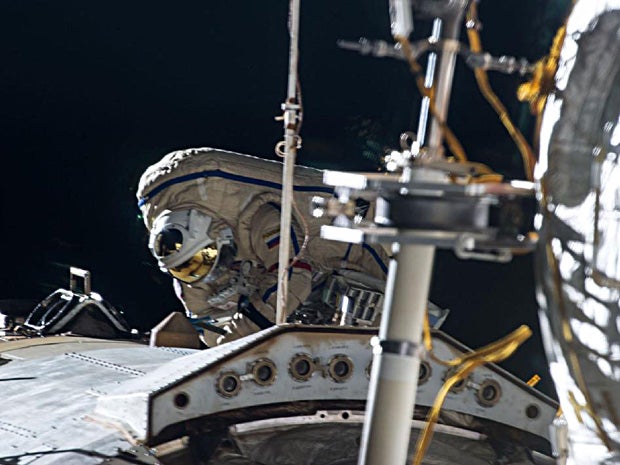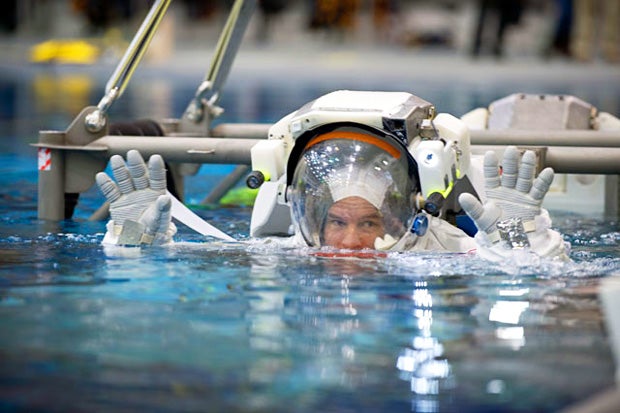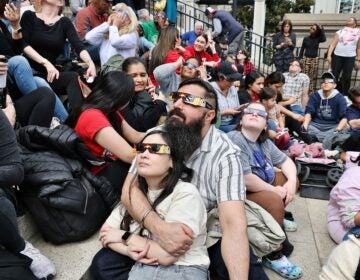Not too old for an “out of this world” walk
ListenAt the age of 59, International Space Station cosmonaut Pavel Vinogradov (pictured above) set a new record last week by becoming the oldest spacewalker ever. Interested in going to Mars? Mars One project applications are being accepted through August 31! Night sky highlights this week: Jupiter lowering to the west, Saturn up all night, Venus just beginning to appear.
April 29, 2013
[Dave Heller] Forty-eight years after the first human conducted an extravehicular activity, also known as a spacewalk, a new out of the world pedestrian record was set this month. Let’s marvel at this feat with Derrick Pitts, chief astronomer at the Franklin Institute. Derrick, Alexei Leonov had that first honor in 1965 and it is again a cosmonaut that enters the record books.
[Derrick Pitts] And there’s a good reason for that. The Russians had been doing so much work in space since the early 1960’s — they hold a lot of the records for human endurance in space and have incredible records of what the space environment has done to the human body. In this particular case, this is the oldest spacewalker ever. It’s cosmonaut Pavel Vinogradov, and he’s one of six that are currently on board International Space Station. And Pavel was out last week installing new equipment onto the exterior of International Space Station with his spacewalking partner, Roman Romanenko. So when Pavel stepped out the hatch, he became the oldest to ever walk in space. His age? A spritely fifty-nine years.
-

Expedition 35 Russian cosmonaut Pavel Vinogradov translates outside the International Space Station on April 19, 2013, during the first spacewalk of the Expedition 35 mission. Vinogradov and fellow cosmonaut Roman Romanenko (out of frame) went on to spend about six hours upgrading the station’s exterior hardware. Photo credit: NASA
I would imagine it’s quite a feat to train to just go into outer space. Is additional training required to then take that spacewalk?
When we first started doing this back in late 50’s and early 60’s, we looked for people who were in absolute prime physical condition. Nowadays, while we still look for people who are in very good physical condition, their limits on their physical capability have broadened tremendously to allow people to live and work in space.
We do look differently at how we train people for different jobs. So for work onboard International Space Station, almost everyone needs to be able to work outside Space Station. So that kind of training is in addition to the regular training that you would get if you were just, say, a Space Shuttle pilot, or if you were a Space Shuttle mission specialist who only worked on board and inside Space Shuttle.
For astronauts who work on International Space Station, they also must be able to work outside. So in addition to the hours they spend just learning how to be an astronaut, there are also the additional training hours that are required to be able to work outside. Now the difference is that it is a different environment. You have all of your life support system on you, so it’s all contained within your suit. And you’re in your suit alone, as if you’re on board your very own spaceship. So there’s that piece you have to deal with. But that also means that, because you’re outside of International Space Station, you constantly have to be aware of where you are in relation to Space Station, your attachments (the most important part of this), and how you handle all the tools you work with, because it’s very easy to lose a tool or lose a piece of equipment. So these are all sets of awareness that you have to have about you as you’re working outside of the Station that you don’t really necessarily have to have working for you while you’re inside Station.
Specifically though, does one have to be more physically fit to take a spacewalk than to merely go up into outer space?
No, one does not have to be more physically fit. So for example, the proverbial “90-pound weakling” that gets the sand kicked in his face at the beach can do a spacewalk just as easily as Charles Atlas, the master muscle-man himself. So it’s not required that you either have bulkier muscles or more capable cardiovascular system, or any of those things. So it’s all about the training.
-

Astronaut Jeffrey Williams, Expedition 21 flight engineer and Expedition 22 commander, attired in a training version of the Extravehicular Mobility Unit (EMU) spacesuit, waves as he is submerged in the waters of the Neutral Buoyancy Laboratory (NBL) near NASA’s Johnson Space Center. SCUBA-equipped divers (out of frame) are in the water to assist Williams in his rehearsal, intended to help prepare him for work on the exterior of the International Space Station. Photo credit: NASA
So the proverbial septuagenarian, namely John Glenn, still holds the record for oldest person in space when in 1998 he went aloft at the age of 77.
And that was quite a ripe age to be going into space because, you know, the rigor is in stress of space flight on the body are not minimal. You certainly do feel effect, and it certainly will ruin your day if you’re not really prepared for it. Thank goodness Glenn had experience, had really good training, and was willing to put up with the rigors of making the flight and the readjustments to being in zero-gravity.
Hey, what kind of conditioning is required to apply to go to Mars?
In fact there’s a company that just opened its application process for people who are interested in travelling to Mars. The project is called Mars One, and last week they were inviting people of reasonably good health, able to get along with others, and above the age of 18 to apply to become possibly the first people to colonize the Red Planet. Their intention is to use this way to establish the first colony on Mars. So, they’re looking for a few good people who are interested in leaving this planet and travelling to Mars. Of course, the only catch about this is there’s no return trip.
Yikes.
You might say that. That’s a major requirement here that applicants understand that they are not planning to develop a technology to bring people back.
Wow, how do they have the audacity to charge $38 for the application then?
It sounds like a lot, doesn’t it? But it’s to Mars for goodness sake! So, why not? The way that they have the audacity is they’re actually using a model that is not so unusual. If you think back on how this planet was explored — 500, 600, 700 years ago, 1,000 years ago — it was explored by people who were willing to take a huge risk. So people would get in sailing ships and set out across an ocean, the other side of which they had no knowledge of its existence. So they did not know there were lands on the other side.
They were even willing to dive off the edge!
And in fact, so many people on the continent thought would happen, but the sailors themselves, of course, learned otherwise. But they were willing to take this risk knowing that there was a very good chance they would not return. Yet, they still wanted to do it with the chance that if they DID return, then they would really benefit tremendously from being the first to go to these places, to be the first to discover. So this is the model that’s being used here for the Mars One project. These folks can be the first to go there, just like ancient explorers did with the risk included that they may not be able to return.
“[Mars One is] looking for a few good people who are interested in leaving this planet and travelling to Mars. Of course, the only catch about this is there’s no return trip.”
Much less risk in heading out of doors to see what’s available in the night sky this week.
Unless you’re worried about meteors crashing down on your head, as has happened in some places over the last couple of weeks! There have been some meteors from what seems to be the Lyrid shower that have crashed through a few buildings [but] haven’t injured anybody. So just take your titanium umbrella out with you this week as you go out to view over the western horizon just after sunset: Venus, just beginning to poke its head up above the horizon, starting to become visible. Slightly higher above Venus we’ll still find the largest planet of the solar system, Jupiter. And then back over on the eastern side of the sky about an hour after sunset, around 9 or 9:30 now, we can find beautiful Saturn right there, easy to see.
-

Venus, Jupiter and the moon. Photo by Flickr user Dave Schumaker
WHYY is your source for fact-based, in-depth journalism and information. As a nonprofit organization, we rely on financial support from readers like you. Please give today.




